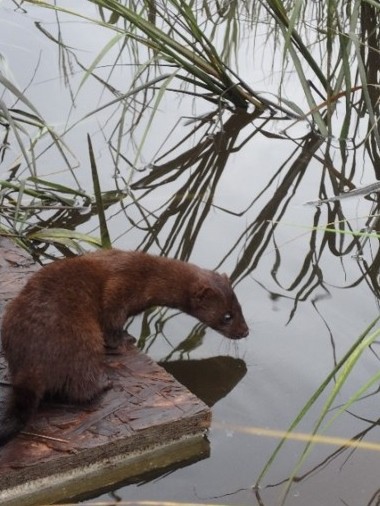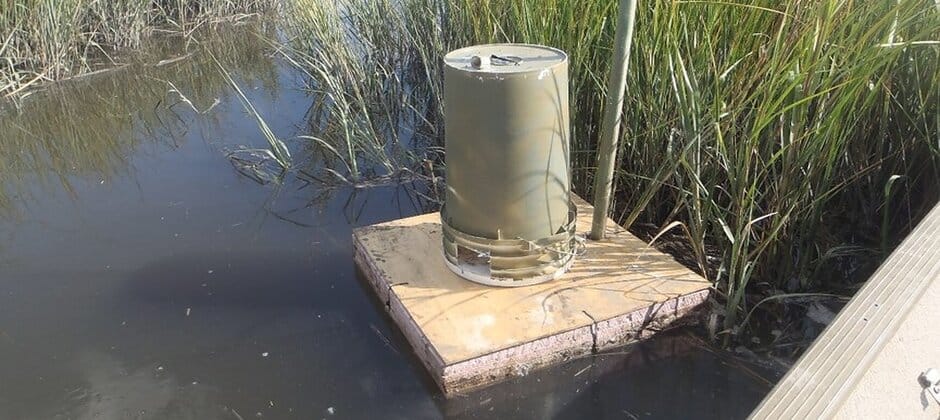Share this article
WSB: Floating trail cameras improve marsh mink detection
The best way to track down Atlantic salt marsh mink, it turns out, may be by using an upside-down bucket floating on a small raft.
Atlantic salt marsh mink are one of four subspecies of mink occurring in Florida. They are considered a species of greatest conservation concern in the state, due in part to their relatively small range. Making matters worse, the ecosystems where the subspecies occurs in in Florida are vulnerable to sea level rise due to climate change.
But researchers know little about the populations of these small, semi-aquatic mammals in the weasel family.
Lisa Smith, a research associate with the Florida Fish and Wildlife Conservation Commission, wanted to learn more about one particular subspecies—the Atlantic salt marsh mink—found in northeastern Florida and into Georgia and South Carolina. Lisa and her colleagues conducted a study published recently in Wildlife Society Bulletin, comparing different mink detection methods. Knowing which method works best, researchers could learn more about where the subspecies is found and how many occur.
The first method the researchers tested was a more traditional technique using spotlights on boats during nighttime surveys. Biologists count the numbers of mink based on the unique way the mammals’ eyes reflect the spotlight at night.
The other method they tested involved trail cameras. The researchers flipped seven-gallon buckets upside down. On each bucket, they cut a hole on one side big enough for a mink to enter. They placed the buckets on 2-foot by 2-foot floating rafts, and equipped the inside with trail cameras facing downward to capture anything that might enter the bucket.
In the beginning, the researchers baited these traps, but they realized that wasn’t even necessary.

Atlantic salt marsh mink are found in northeastern Florida. Courtesy of Lisa Smith
“You don’t even have to use bait,” Smith said. “They just like a bucket—they’ll come and check it out.”
The researchers found that the floating bucket method was superior to the spotlight method for surveying Atlantic salt marsh mink. It was so good that Smith even encountered a mink in one of the buckets once while checking trail cameras.
“I dumped one out of a bucket once by accident—I didn’t realize it was sleeping,” Smith said. “I picked it up, and boy did the thing jump out of there.”
The trail cameras detected a lot more mink at the same sites by using the bucket method versus the spotlight surveys. They could detect mink over a wider variety of microhabitats than would be accessible by boat using spotlights, Smith said. The trail camera setup also allowed for the detection of mink over 24-hour periods—an advantage over the nighttime survey method since mink are more active during dawn and dusk. It also allowed them to survey mink at low tide, which is difficult to do by boat.
The only drawbacks of the trail cameras were the cost and time it took to survey. While boat spotlight surveys were conducted over a few nights, the researchers left the trail cameras out for two weeks. Boat surveys also covered at least 20 kilometers per night—much more ground than the 1 square kilometer per camera.
The surveys are already teaching researchers more about Atlantic salt marsh mink. For example, mink are mostly found in Nassau and Duval counties, but not St. Johns County. This shrinks the known range by half of what was previously believed.
“We found out they were a lot more range restricted than we thought,” Smith said.
Nonetheless, the mink appear relatively abundant in the counties where they were found. The cameras also revealed some ecological interactions, such as mink dragging clapper rails into buckets as a meal. Researchers plan to build upon this research to evaluate habitat and study the related and rare subspecies, the Gulf salt marsh mink (Mustela vison halilimnetes).
This article features research that was published in a TWS peer-reviewed journal. Individual online access to all TWS journal articles is a benefit of membership. Join TWS now to read the latest in wildlife research.
Header Image: An upturned bucket with a camera inside of it. Credit: Lisa Smith








